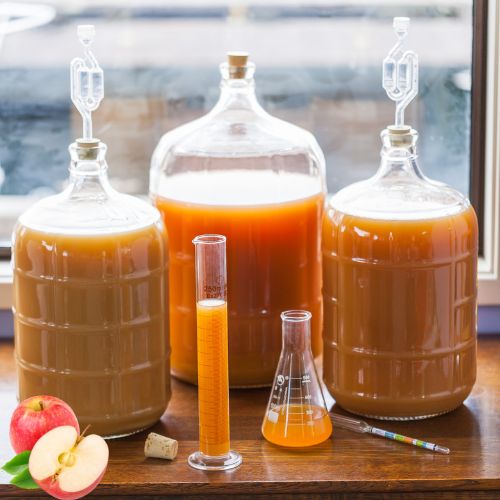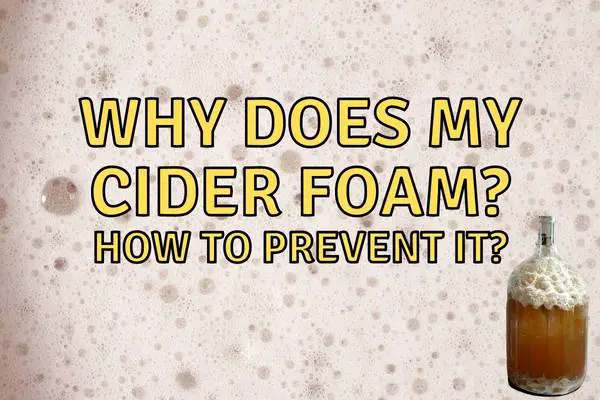The foam on top of your apple cider and beer is sometimes called “krausen” and is normal during fermentation of especially gluten-containing beers and ciders made from the juice of high protein or pectin-rich apples.
Foam forms as a result of aggressive fermentation where CO2 bubbles get caught in polymers of protein and carbohydrates present in the cider.
The best approach to get rid of the foam (krausen) in your brewing cider is to cut the complex carbohydrates into pieces with enzymes. Another way is to manipulate the surface tension of the brew to destabilize the foam structures.
I’ll show you how in this post!
What is cider foam (krausen) made of?
It is caused by the release of carbon dioxide gas from the yeast cells that interact with long chains of proteins and carbohydrates in the brew.

Although apple cider contains less protein than beer wort, there will always be some present (otherwise the yeast would not survive!).
Carbohydrates such as pectin in most fruits will also take a minor part in these reactions, but are slowly broken down during the process and should disappear as the fermentation moves along.
What can I do to prevent foaming cider?
If your apple juice has been obtained using a high-speed kitchen juicer or similar, there will also be lots of foam forming just from the harsh extraction process that denatures the proteins and leads to foam from the beginning.
In this case, the foam can simply be removed straight away (and tastes quite good when frozen as ice cream!).

Also, juice that has been obtained without much filtration of larger particles will contain more proteins.
So a cleaner and slower extraction process will generally lead to less foaming. But it also depends on the types of apples and yeast used.
Generally, the yeasts used for wines and champagne produce less foam than slower beer and dedicated cider yeasts.
Also, make sure that you do not fill your fermentation container all the way to the top.

As a bit of foam formation is inevitable, it is important to leave at least a few inches of head space to allow the foam to form without giving it the opportunity to escape through the airlock!
How can I get rid of foam in my cider?
Whereas the foam will usually disappear on its own within a few days, there are a few things you can do if you risk overflow/blowout due to excessive foam:
1. Add some pectinase
Pectinase is a pectin-cutting enzyme. Pectin is a carbohydrate widely present in the cell wall of fruit cells and will be released into the cider when pressed.
Just as for proteins, pectin is a complex molecule that makes your cider hazy and will be able to foam upon vigorous carbon dioxide formation.
This will clear out the pectin to make a clearer cider but will also break up some of the long polymer chains that cause the foaming. However, this is likely to be less effective than proteinases.
2. Add proteinase to break protein foam
Proteinases are protein-cutting enzymes that can be added to your brew. They will break up the protein chains and split the foam apart.
Proteinases are naturally found in pineapple juice and a few (non-heat treated!) drops can be added to the brew in an early stage to break up the foam.
Like pectinases, proteinases are sensitive to alcohol, so you should add them as early as you see the first signs of foaming.
3. Move your fermenter to a colder location.
To slow down the fermentation and reduce the CO2 formation that “inflates” the protein structures to form the foam, try brewing your cider at lower temperatures.
The colder temperatures will help to prevent overflow reactions where the foam exists through the airlock. And it might also improve the taste of your cider!
However, this will also slow the process of foam breakdown. So although the foam will be less severe, it might hang around for a long time!
4. Try gently swirling the brew
in circular motions to force the foam to collapse onto the sides of the fermentation vessel. This only works with enough head space, otherwise, the foam might escape through the airlock!
You can also try gently stirring the cider, but this requires you to take off the airlock, which is only advisable at the beginning of the fermentation!
5. Spray some oil on top of the foam.
The oil particles will interact with the hydrophobic proteins and collapse them around the oil particles instead of expanding the foam structure.
In this way, the foam may collapse altogether or never form at all if used early on in the fermentation process!
It is best to use taste-neutral oil that does not go rancid too easily. For example mild olive oil or other neutral cooking oils.
6. Usie fining agents
Fining agents are negatively charged molecules or particles that will interact with the often positively charged large polymers that form haziness, off-tastes, and foam in wine and cider.
In the old days, horse blood and egg whites would be used, but I would not recommend using that…
Instead, you can buy different types of fining agents such as:
Gelatine, Isinglass, Egg albumen powder, Casein from milk, Bentonite, Carbon, and Polyvinylpolypyrrolidone (PVPP).
These are often used to clear wine and remove tannins and other bitter-tasting compounds from the brew.
However, they can also be used to precipitate pectins and larger proteins at the beginning of the brewing process to prevent foaming.
Overall, it is best to experiment a little and see what works best for you and the type of cider you are making.
Conclusion
Foam can be a normal part of the fermentation process for apple cider, but it can also be caused by extraction methods, the type of apples used, or the type of yeast.
To prevent foam, use a slow extraction process and leave some head space in the fermentation container.
To get rid of foam, add proteinase or pectinase, move the fermenter to a colder location, swirl the brew gently, spray oil on top of the foam, or use a fining agent.
Stirring should only be done if really necessary as it risks contamination and oxygen exposure. Otherwise, just let the CO2 do its job and the foam will eventually subside.




